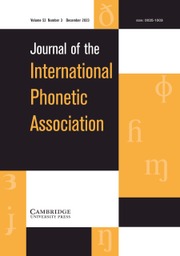Crossref Citations
This article has been cited by the following publications. This list is generated based on data provided by
Crossref.
Purcell, David W.
and
Munhall, Kevin G.
2006.
Adaptive control of vowel formant frequency: Evidence from real-time formant manipulation.
The Journal of the Acoustical Society of America,
Vol. 120,
Issue. 2,
p.
966.
de Jong, Gea
McDougall, Kirsty
and
Nolan, Francis
2007.
Speaker Classification II.
Vol. 4441,
Issue. ,
p.
130.
Tabain, Marija
and
Perrier, Pascal
2007.
An articulatory and acoustic study of /u/ in preboundary position in French: The interaction of compensatory articulation, neutralization avoidance and featural enhancement.
Journal of Phonetics,
Vol. 35,
Issue. 2,
p.
135.
Fabricius, Anne H.
2007.
Variation and change in thetrapandstrutvowels of RP: a real time comparison of five acoustic data sets.
Journal of the International Phonetic Association,
Vol. 37,
Issue. 3,
p.
293.
Schmitt, Holger
2007.
The case for the epsilon symbol (ε) in RP dress.
Journal of the International Phonetic Association,
Vol. 37,
Issue. 3,
p.
321.
Harrington, Jonathan
Kleber, Felicitas
and
Reubold, Ulrich
2008.
Compensation for coarticulation, /u/-fronting, and sound change in standard southern British: An acoustic and perceptual study.
The Journal of the Acoustical Society of America,
Vol. 123,
Issue. 5,
p.
2825.
Tabain1, Marija
2008.
Production of Australian English language-specific variability.
Australian Journal of Linguistics,
Vol. 28,
Issue. 2,
p.
195.
Fabricius, Anne
2008.
Using angle calculations to demonstrate vowel shifts.
Acta Linguistica Hafniensia,
Vol. 40,
Issue. 1,
p.
7.
Kamiyama, Takeki
and
Vaissière, Jacqueline
2009.
Perception and production of French close and close-mid rounded vowels by Japanese-speaking learners.
Acquisition et interaction en langue étrangère,
p.
9.
Zhao, Lingling
and
Yang, Kuihe
2009.
An Improved Distinguishing Different Vowel Sounds of Language Approach.
p.
375.
OhEunjin
2009.
The High Vowel Systems of Korean-English Bilingual Speakers.
Korean Journal of English Language and Linguistics,
Vol. 9,
Issue. 4,
p.
633.
Zhao, Lingling
and
Yang, Kuihe
2009.
Application of Vowel Recognition Model Based on Improved SVM Algorithm.
p.
1.
Ferragne, Emmanuel
and
Pellegrino, François
2010.
Vowel systems and accent similarity in the British Isles: Exploiting multidimensional acoustic distances in phonetics.
Journal of Phonetics,
Vol. 38,
Issue. 4,
p.
526.
Escudero, Paola
and
Chládková, Kateřina
2010.
Spanish listeners’ perception of American and Southern British English vowels.
The Journal of the Acoustical Society of America,
Vol. 128,
Issue. 5,
p.
EL254.
OhEunjin
2010.
The Coronal Stop Places of Early Korean-English Bilingual Speakers.
Korean Journal of Linguistics,
Vol. 35,
Issue. 1,
p.
155.
Ferragne, Emmanuel
and
Pellegrino, François
2010.
Formant frequencies of vowels in 13 accents of the British Isles.
Journal of the International Phonetic Association,
Vol. 40,
Issue. 1,
p.
1.
DETERDING, DAVID
2010.
Norms for pronunciation in Southeast Asia.
World Englishes,
Vol. 29,
Issue. 3,
p.
364.
Mesthrie, Rajend
2010.
Socio‐phonetics and social change: Deracialisation of the GOOSE vowel in South African English1.
Journal of Sociolinguistics,
Vol. 14,
Issue. 1,
p.
3.
PILLAI, STEFANIE
MOHD. DON, ZURAIDAH
KNOWLES, GERALD
and
TANG, JENNIFER
2010.
Malaysian English: an instrumental analysis of vowel contrasts.
World Englishes,
Vol. 29,
Issue. 2,
p.
159.
MAYR, ROBERT
and
ESCUDERO, PAOLA
2010.
Explaining individual variation in L2 perception: Rounded vowels in English learners of German.
Bilingualism: Language and Cognition,
Vol. 13,
Issue. 3,
p.
279.


